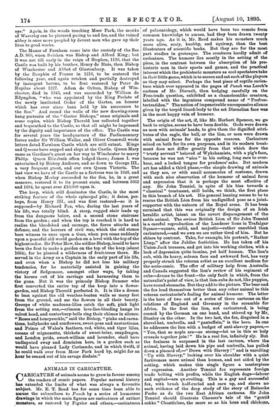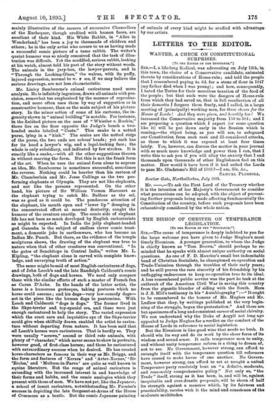ANIMALS IN CARICATURE.
CARICATURE of animals seems to grow in favour among the readers of comic papers. Popular natural history has extended the limits of what was always a favourite subject. Mr. E. T. Reed has for some time been able to amuse the subscribers to Punch by a series of humorous drawings in which the main figures are caricatures of extinct .monsters, as restored by Fignier and others,—caricatures
of paleontology, which would have been too remote from common knowledge to amuse, had they been drawn twenty years ago. As it is, Mr. Reed makes his monsters much more alive, scaly, knobby, and squirmy, than the beat illustrators of scientific books. But they are for the most part studies in grotesque. The creatures hardly admit of caricature. The humour lies mostly in the setting of the piece, in the contrast between the absorption of his pre- historic men in their sports and games, and the practical interest which the prehistoric monsters as cool spectators take in their little game, which is to secure and eat such of the players as they may select. Perhaps the beat piece of reptile carica- ture which ever appeared in the pages of Punch was Leech's cartoon of Mr. Disraeli, then hedging carefully on the Free-trade question, exhibited as a chameleonlike creature, labelled with the ingenious compound name of " Profree- tectratidon." The notion of impenetrable unresponsive silence given by the torpid lizard-body to the set Disraelian face was in the most happy vein of humour.
The origin of the art, if, like Mr. Herbert Spencer, we go back to origins, seems to have been double. Gods were drawn as men with animals' heads, to give them the dignified attri- butes of the eagle, the ball, or the lion, or men were drawn with animal faces for the opposite reasons. Caricature seized on both for its own purposes, and in its modern treat- ment does not differ greatly from that which drew the "trusty servant" beloved of Wykehamists, with a pig's face, because he was not "nice" in his eating, long ears to over- hear, and a locked tongue for prudence' sake. But modern art has added a third phase,—the simple drawing of animals as they are, or with small accessories of costume, drawn with such nice observation of the humour of animal form and expression that it is perhaps the most effective of any. Sir John Tenniel, in spite of his bias towards a " classical " treatment, still holds, we think, the first place in this branch of his art. His general leaning seems to be to rescue the British Lion from his undignified pose as a joint.. supporterwith the unicorn of the Royal arms. It has been surmised that this was originally the design of an Irish heraldic artist, intent on the covert disparagement of the noble animal. The serious British Lion of Sir John Tenniel is a careful reproduction of the Landseer lions in Trafalgar Square—square, solid, and majestic—rather ennobled than caricatured,—and we own we are rather tired of him. But he shines by contrast. Take, for example, his portrait, "Rather Limp," after the Jubilee festivities. He has taken off his Union-Jack trousers, and got into his working clothes, with a look of depression quite leonine, yet half human. The lion's cub, with its heavy, solemn face and awkward feet, has very properly struck the veteran artist as an excellent medium for the serio-comic. The offer of military help from Australia. and Canada suggested the lion's review of his regiment of cubs—drums to the front—the only fault in which, from the naturalist's point of view, is that lion-cubs do not, like puppies, have round stomachs. But they add to the picture. The bear and the fox lend themselves better than any other animal to this veteran caricaturist's feeling for animal humour. The latter is the hero of two out of a series of three cartoons on the relations of England and Germany in the scramble for Africa. In the first the lion, not caricatured, is being coaxed by the German on one hand, and stirred up by Mr, Stanley on the other. In the two last, the fox, disguised in shovel-hat, umbrella, and " pantoffeln," is the hero. In one he addresses the lion with a budget of anti-slavery papers,— " You, that so nople are—so strong—let us in this so holy crusade together join ! " He is a real fox, infinitely sly. But the foxiness is surpassed in the last cartoon, where the animal, having laid down his pipe and umbrella, has pulled down a placard of,—" Down with Slavery ! " and is unrolling- " Up with Slavery," looking over his shoulder with a quiet furtiveness more animal than human, and not aided by the setting, which makes this single figure a masterpiece of expression. Another Tenniel fox represents foreign trade bolting with profits, while the English dogs—labour and capital—are qu trrelling. This is a gay and successful fox, with brush half-curled and ears up, and shows no such evidence of the deep study of the story of Reinecke Fuchs as do the two East African cartoons. Sir John Tenniel should illustrate Chancer's tale of the " gentil cokke " Chanticlere, the more so as his hens and chickens, imainly illustrative of the careers of successive Chancellors of the Exchequer, though credited with human faces, are excellent of their kind. His White Rabbit, in "Alice in Wonderland," has been a joy to thousands of children and others ; he is the only artist who occurs to us as having made a successful comic picture of a tame rabbit. The writer's quaint humour was so nicely conceived that the task of illus- tration was difficult. Yet the muddled, serious rabbit, looking at his watch, almost told his part of the story without words. The animals in the jury-box, the lawyer-parrots, and in 4‘ Through the Looking-Glass," the walrus, with its puffy, injured expression, normal to w r ses, if we may believe the serious drawings, are not less characteristic.
Mr. Linley Sambourne's animal caricatures need more analysis. He is infinitely ingenious, draws all animals with pre- cision, somewhat too emphasised by the manner of reproduc- tion, and more often uses them by way of suggestion or in constructive humour, than as the main subject of his picture- story. In the minor action of some of his cartoons, the in- genuity shown in "animal building" is notable. For instance, in the finiehed picture on the case of "Whistler v. Ruskin," there lies on the floor opposite the Judge's bench a two- headed snake labelled "Costs." This snake is a netted purse, lying in a "kink." The scales are the netted rings of the purse, the two ends are cobras' heads ; yet each has for its hood a lawyer's wig, and a legal-looking face; the whole is only subsidiary, and indicated by few strokes. It is exactly like a snake,—with all the other suggestions thrown in without marring the form. But this is not the frank form of the art. When he uses the animal form alone to express an idea, Mr. Sambourne is sometimes successful, sometimes the reverse. Nothing could be heavier than his cartoon of Mr. Chamberlain and Mr. Jesse Collings as the two per- forming elephants at Olympia. They are not like elephants, and not like the persons represented. On the other hand, his picture of Sir William Vernon Harcourt as the elephant trying to catch Mr. Balfour as the eel, was as good as it could be. The ponderous attention of the elephant, his mouth open and "lower lip" drooping in the concentrated effort at manual dexterity, caught the humour of the creature exactly. The comic side of elephant life has not been as much developed by English caricaturists as might be expected. In India the jolly elephant-headed god Ganesha is the subject of endless clever comic treat- ment, a domestic joke in earthenware, who has become an Indian Mr. Punch. But there, as the evidence of the temple sculptures shows, the drawing of the elephant was true to nature when that of other creatures was conventional. "In the gates of Sanchitope in Central India," writes Mr. L. Kipling, "the elephant alone is carved with complete know- ledge, and unvarying truth of action."
The same might be said of most English caricatures of dogs, and of John Leech's and the late Randolph Caldecott's comic drawings, both of dogs and horses. We need only compare these with the similar efforts of such a master of French fun as Caran D'Ache. In the hands of the latter artist, the horse is a humorous grotesque, taking postures which no horse could assume ; and his dogs—very low-comedy dogs— act in the piece like the human dogs in pantomime. With Leech and Caldecott "dogs is dogs." The former lived in the Skye-tenier and toy-spaniel era, and these were just enough caricatured to help the story. The varied expression which the erect ears and inquisitive eye of the Skye-terrier could give when skilfully drawn enabled the artist to carica- ture without departing from nature. It has been said that o2l Leech's horses were caricatures. That is hardly so. They were usually "screws," second or third rate animals, with plenty of "character," which never seems to show in portraits, however good, of first-class horses; and these he caricatured with extraordinary success when be desired. He has created horse-characters as famous in their way as Mr. Briggs, and the form and features of 'Xerxes' and 'Arter-Xerxes,' Sir 'Ercles,' and Multum-in-Parvo ' are quite as well known in equine literature. But the range of animal caricature is extending with the increased interest in and knowledge of their forms and habits, and the comic analogies which they present with those of men. We have not yet, like the Japanese, a school of insect caricature, notwithstanding Mr. Furniss's success in depicting the late Sergeant-at-Arms of the House of Commons as a beetle. But the comic Japanese painting
of animals of every kind might be studied with advantage. by our artists.



































 Previous page
Previous page